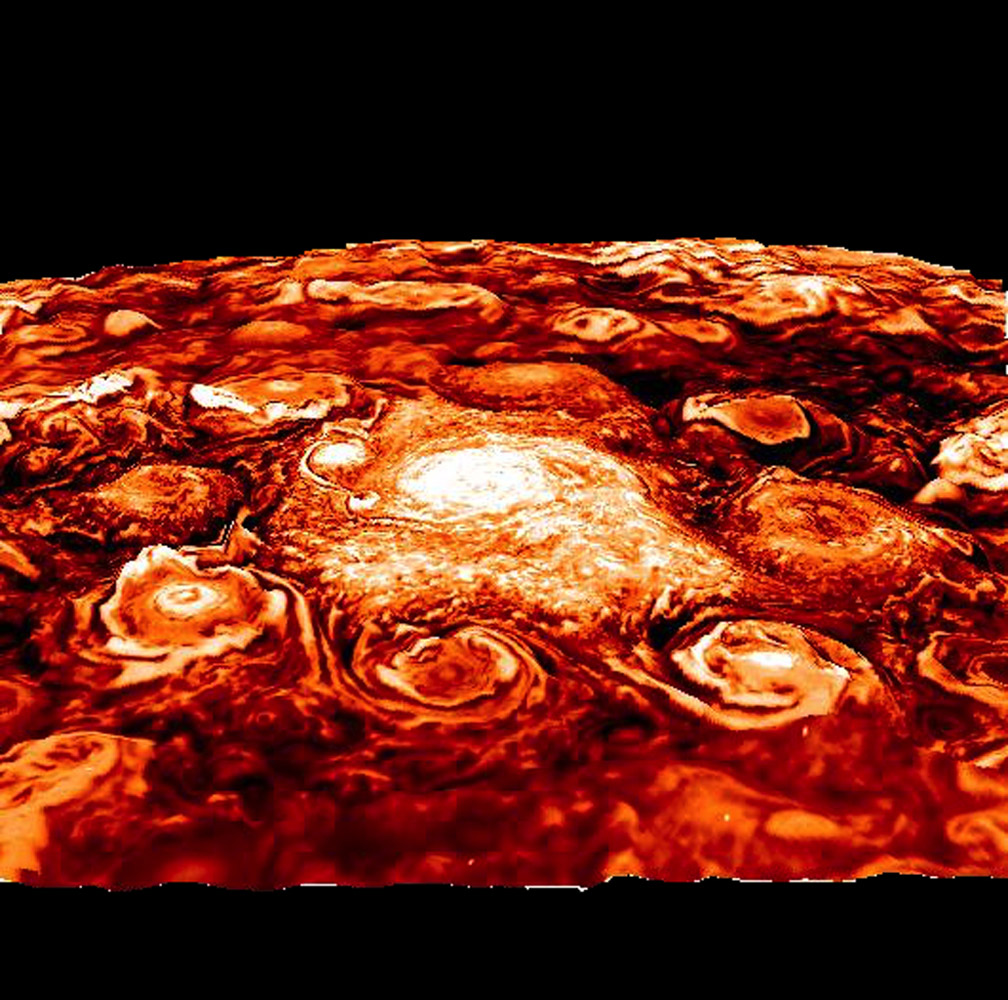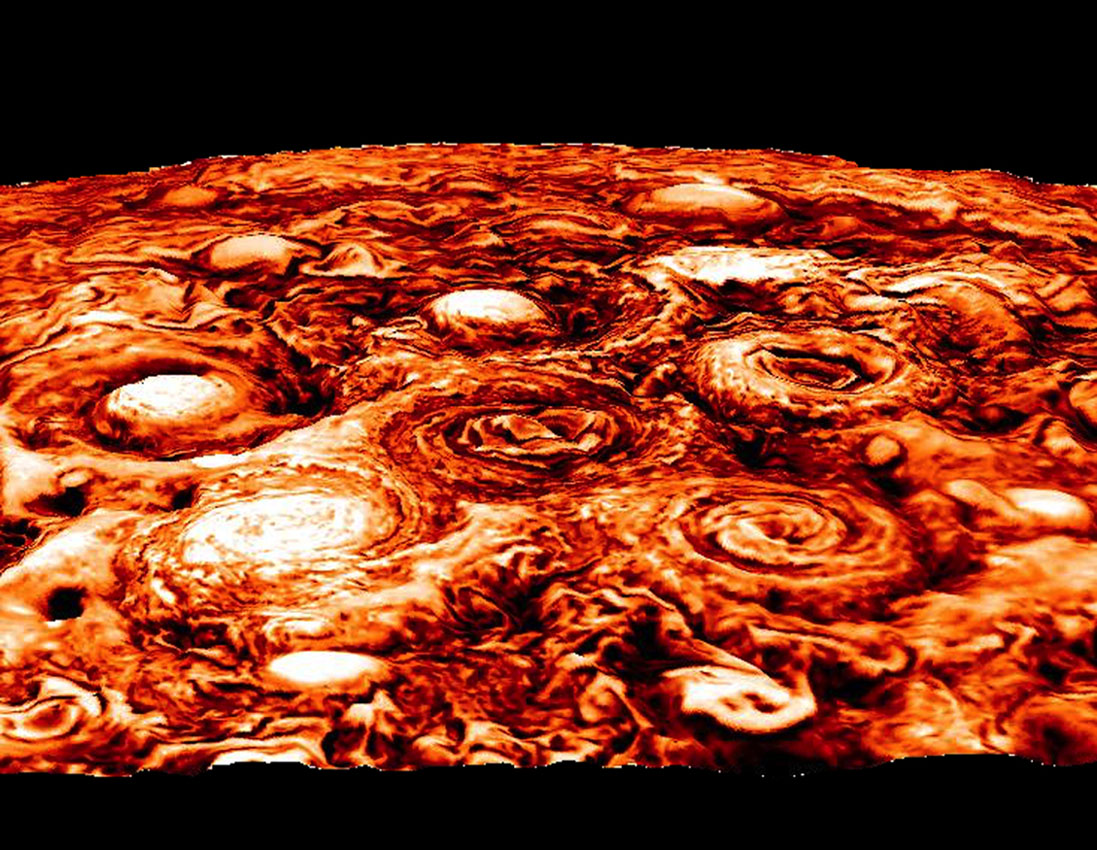BY
NASA’s Juno space probe is on a multi-year mission to explore the origins and evolution of the gas giant Jupiter—it’s serious science.
But Instagrammers have shared some rather unserious observations of Juno’s highly detailed infrared image posted on the space agency’s Instagram page.
You could say their comments are way out to lunch—but way out for pizza would be more accurate.
The image shows in incredible detail the cyclones and anticyclones of Jupiter’s North Pole—taken from Juno’s Infrared Auroral Mapper (which measures the thermal emissions from the Jovian cloud tops)—and Instagrammers noted a striking resemblance to red, round pepperoni slices nestled in a gooey bed of melted mozzarella.
That would be one HUGE pizza, though.
The surveyed area (the pizza), just offset from Jupiter’s polar region, features a central cyclone surrounded by eight others, each ranging from 2,500 to 2,900 miles across. Each outer storm looks as if it’s “blowing in tribute” to the central storm. “Their spiral arms smack together as they spin, but the storms don’t merge,” NASA’s website says.
Here is the image taken by Juno:

This composite image, derived from data collected by the Jovian Infrared Auroral Mapper (JIRAM) instrument aboard NASA’s Juno mission to Jupiter, shows the central cyclone at the planet’s North Pole and the eight cyclones that encircle it. (NASA/JPL-Caltech/SwRI/ASI/INAF/JIRAM)
The pepperoni and cheese likeness was so strong that, judging from responses on Instagram, commenters couldn’t think of much else besides. They dropped comments like: “I thought this was a pepperoni pizza,” and “LOOKS LIKE A PIZZA,” and “Seems a burned pizza,” as well as “Pizza Planet 🍕🍕🍕.”
One person even threw in an entirely different (but wholly appropriate) “Forbidden cinnamon rolls” comment.
And there were other, non-food comparisons. One person noted: “For a moment I thought it was the Sun;” while NASA’s own caption shared something similar: “The floor is lava! Oh wait, nevermind, that’s just an infrared look at Jupiter’s North Pole 😉.”

This computer-generated image is based on an infrared image of Jupiter’s north polar region that was acquired on Feb. 2, 2017, by the Jovian Infrared Auroral Mapper (JIRAM) instrument aboard Juno during the spacecraft’s fourth pass over Jupiter. (NASA/JPL-Caltech/SwRI/ASI/INAF/JIRAM)
Lava, indeed.
The thermal image measures the temperature of Jupiter’s atmosphere, with warmer areas displayed in yellow (deeper into Jupiter’s atmosphere) (about -13°C/ 9°F) and cooler areas appearing darker (at higher altitude) (about -83°C/ -117°F). And the appearance does seem lava-like.
Yet, there is another purpose behind the infrared imaging: It allows Juno to map areas of the planet not illuminated by sunlight using the atmosphere’s own ambient radiation.
As for the Jovian South Pole, similar data shows a central polar cyclone with five circumpolar cyclones, which are slightly larger than their northern counterparts.
“Like in the North, Jupiter’s south pole also contains a central cyclone, but it is surrounded by five cyclones with diameters ranging from 3,500 to 4,300 miles (5,600 to 7,000 kilometers) in diameter,” NASA’s website says.

This computer-generated image shows the structure of the cyclonic pattern observed over Jupiter’s south pole. (NASA/JPL-Caltech/SwRI/ASI/INAF/JIRAM)
Alberto Adriani, Juno co-investigator from the Institute for Space Astrophysics and Planetology, explained on the space agency’s website:
“Prior to Juno we did not know what the weather was like near Jupiter’s poles. Now, we have been able to observe the polar weather up-close every two months.
“Each one of the northern cyclones is almost as wide as the distance between Naples, Italy and New York City—and the southern ones are even larger than that. They have very violent winds, reaching, in some cases, speeds as great as 220 mph (350 kph).
“Finally, and perhaps most remarkably, they are very close together and enduring. There is nothing else like it that we know of in the solar system.”
That might not be quite accurate, however, as we know of one Italian pie-shaped dish that bears a striking resemblance.
We would love to hear your stories! You can share them with us at [email protected]
Republished with Permission The Epoch Times SUBSCRIBE
Get Citizensjournal.us Headlines free SUBSCRIPTION. Keep us publishing – DONATE




